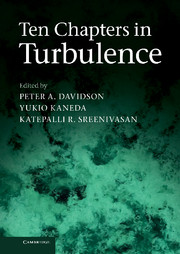Book contents
- Frontmatter
- Contents
- Preface
- Contributors
- 1 Small-Scale Statistics and Structure of Turbulence – in the Light of High Resolution Direct Numerical Simulation
- 2 Structure and Dynamics of Vorticity in Turbulence
- 3 Passive Scalar Transport in Turbulence: A Computational Perspective
- 4 A Lagrangian View of Turbulent Dispersion and Mixing
- 5 The Eddies and Scales of Wall Turbulence
- 6 Dynamics of Wall-Bounded Turbulence
- 7 Recent Progress in Stratified Turbulence
- 8 Rapidly-Rotating Turbulence: An Experimental Perspective
- 9 MHD Dynamos and Turbulence
- 10 How Similar is Quantum Turbulence to Classical Turbulence?
- References
4 - A Lagrangian View of Turbulent Dispersion and Mixing
Published online by Cambridge University Press: 05 February 2013
- Frontmatter
- Contents
- Preface
- Contributors
- 1 Small-Scale Statistics and Structure of Turbulence – in the Light of High Resolution Direct Numerical Simulation
- 2 Structure and Dynamics of Vorticity in Turbulence
- 3 Passive Scalar Transport in Turbulence: A Computational Perspective
- 4 A Lagrangian View of Turbulent Dispersion and Mixing
- 5 The Eddies and Scales of Wall Turbulence
- 6 Dynamics of Wall-Bounded Turbulence
- 7 Recent Progress in Stratified Turbulence
- 8 Rapidly-Rotating Turbulence: An Experimental Perspective
- 9 MHD Dynamos and Turbulence
- 10 How Similar is Quantum Turbulence to Classical Turbulence?
- References
Summary
Introduction
For good practical reasons, most experimental observations of turbulent flow are made at fixed points x in space at time t and most numerical calculations are performed on a fixed spatial grid and at fixed times. On the other hand, it is possible to describe the flow in terms of the velocity and concentration (and other quantities of interest) at a point moving with the flow. This is known as a Lagrangian description of the flow ((Monin and Yaglom, 1971)). The position of this point x+(t; x0, t0) is a function of time and of some initial point x0 and time t0 at which it was identified or “labelled”. Its velocity is the velocity of the fluid where it happens to be at time t, u+ (t; x0, t0) = u(x+(t), t). We will use the superscript (+) to denote Lagrangian quantities, and quantities after the semi-colon are independent parameters. We refer to a point moving in this way as a fluid particle.
Flow statistics obtained at fixed points and times are known as Eulerian statistics. On the other hand, statistics obtained at specific times by sampling over trajectories, which at some reference times passed through fixed points, are known as Lagrangian statistics. For example, the mean displacement at time t of those particles that passed through the point x0 at time t0 is just 〈x+ (t; x0, t0) − x0〉. In both cases, the measurement time t can be earlier or later than the reference time.
- Type
- Chapter
- Information
- Ten Chapters in Turbulence , pp. 132 - 175Publisher: Cambridge University PressPrint publication year: 2012
References
- 4
- Cited by

